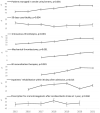Developments in quality of stroke care in Estonia
- PMID: 36793745
- PMCID: PMC9923126
- DOI: 10.1177/23969873221110745
Developments in quality of stroke care in Estonia
Abstract
Background: Monitoring and measuring different aspects of stroke care pathway is the cornerstone for improvement of quality. We aim to analyze and give an overview of improvements of stroke care quality in Estonia.
Patients and methods: National stroke care quality indicators are collected and reported using reimbursement data and include all adult stroke cases. In Estonia, five stroke-ready hospitals are participating in Registry of Stroke Care Quality (RES-Q), providing data on all stroke patients 1 month every year. Data from the national quality indicators and RES-Q from 2015 to 2021 are presented.
Results: The proportion of intravenous thrombolysis for all Estonian hospitalized ischemic stroke cases increased from 16% (95% Confidence Interval, CI 15%-18%) in 2015 to 28% (95% CI 27%-30%) in 2021. Mechanical thrombectomy was provided to 9% (95% CI 8%-10%) in 2021. The 30-day mortality rate has decreased from 21% (95% CI 20%-23%) to 19% (95% CI 18%-20%). More than 90% of patients with cardioembolic stroke are prescribed anticoagulants at discharge, but only 50% are on anticoagulant treatment 1 year after stroke. Also, the availability of inpatient rehabilitation needs improvement, being 21% (95% CI 20%-23%) in 2021. A total of 848 patients are included in the RES-Q. The proportion of patients receiving recanalization therapies was comparable to the national stroke care quality indicators. All stroke-ready hospitals show good onset-to-door times.
Conclusion: The overall stroke care quality in Estonia is good, especially the availability of recanalization treatments. However, secondary prevention and the availability of rehabilitation services need improvement in the future.
Keywords: Estonia; Stroke; quality; registry.
© European Stroke Organisation 2022.
Conflict of interest statement
The author(s) declared no potential conflicts of interest with respect to the research, authorship, and/or publication of this article.
Figures





References
-
- Hsieh FI, Lien LM, Chen ST, et al.. Get with the guidelines-stroke performance indicators: surveillance of stroke care in the Taiwan stroke registry get with the guidelines-stroke in Taiwan. Circulation 2010; 122: 1116–1123. - PubMed
MeSH terms
LinkOut - more resources
Full Text Sources
Medical

